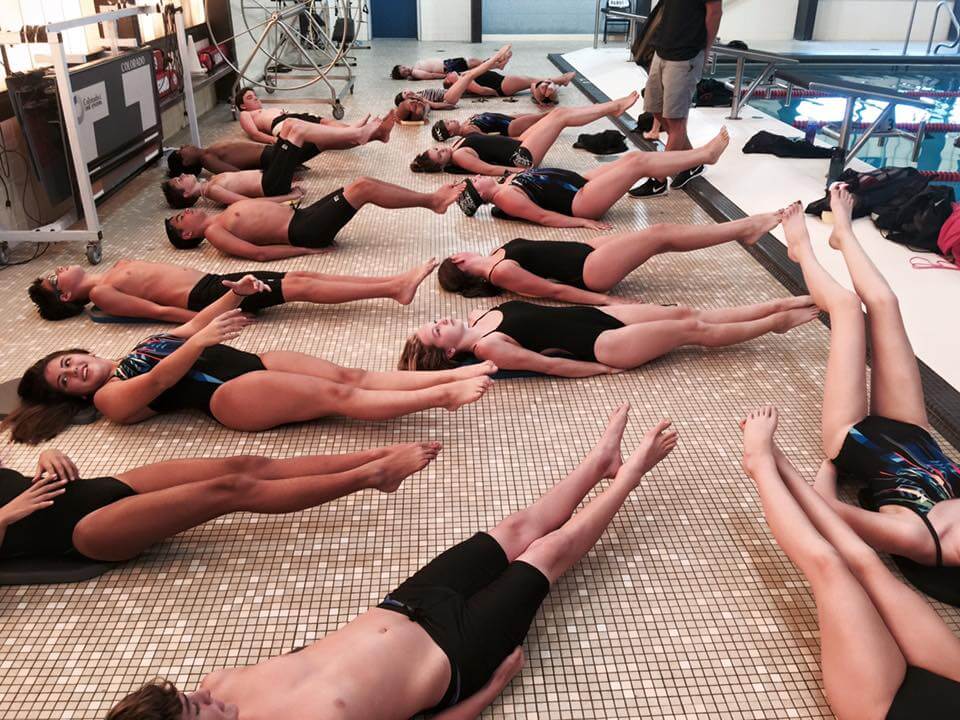4 Key Exercises to Help Improve Performance

4 Key Exercises to Help Improve Performance
Over the past few months, practices have been shortened and pool space has been limited. With health department guidelines and social distancing rules, dryland workouts cannot be completed as efficiently as they have in the past. This has led to dryland training being shortened or completely taken out of the picture. Many athletes claim that they are out of shape and have lost their technique in the water. With all the extra time at home, what are some dryland exercises that can be done to restore this loss in technique?
Flutter Kicks
Most age-group swimmers know the main focus of this exercise. Short fast kicks on your back that use the legs to work on the motions of kicking. While swimmers focus on engaging the legs, remembering that engaging the core will not just make the kicks harder, but more powerful and effective. These short fast kicks are done by laying on your back with your hands at your side and bringing your feet up just about five inches. Then you start the flutter kicks. Doing this for 30 seconds to one minute can allow your body to feel a stretch in the core area. After you have the basics down, there is a twist you can add to make it even more challenging. When laying on your back and doing the kicks, place your arms into a streamline position and hold it as you kick. This makes the exercise significantly harder but will overall improve ab and leg strength.
Streamline Squats
The second exercise combines the normal squat with the very important streamline position. These are completed by doing a squat down to a 90° angle at the knees, then jumping up into an explosive streamline. These are supposed to mimic the time spent pushing off of the wall after a turn. To make the streamline squats more challenging you can add a three second hold at the bottom of the squat. This combination gives the legs a very good workout and prepares swimmers for the feeling of pushing off the wall during a race.
Start Jumps
The next exercise is not as rigorous as the previous, but is very productive when teaching swimmers about reaction time. To start this exercise you place your feet in your starting stance and touch the ground as if you are grabbing into the blocks. You take your mark and someone (your coach or peer) says go and you jump as high and forward as you can. This should lead to a stretch in the leg pushing you forward.
Burpees
The final exercise that many swimmers dread hearing are burpees. Burpees are one of the best ways to get better at an explosive push-off or turn. To do these in the best way, taking each part of the exercise slowly will get the best results. Start by dropping to the ground into push up position then completing a push up getting your chest as close to the ground as you can. Then bring your knees in and jump up into a tight streamline. Once you get this rhythm down, burpees can build core, arm and leg strength.
These exercises can play a key role for staying in shape. Especially during this difficult time, it is important to work on the dryland activities that will strengthen swimmers’ performances in the water. By doing a few rounds of each of these dryland exercises a day, strength will start to build in and out of the water.
All commentaries are the opinion of the author and do not necessarily reflect the views of Swimming World Magazine nor its staff.




It’s no wonder swimmers don’t like dryland when silly exercises and explanations are offered.
For instance “Doing this for 30 seconds to one minute can allow your body to feel a stretch in the core area. ” Doing flutter kicks do not stretch the core area, they contract it, the exact opposite.
The power in swimming does not come from the kicks, it comes from the rotation of the hips. Dryland exercises that improve hip rotation would not only be more productive, they would also be more enjoyable.
Our swimmers routinely cut their stroke count in half when we increase the the speed of their hips.
In addition, starts and turns are only 10% of any race. The other 90%, when you are actually swimming, is what wins races.
Well maybe but Dressle clearly won the world championship on the strength of his start. Maybe not an issue with younger USA swimmers but when swimming between the walls there is little difference in top performers. Find your advantage where you can. A 1% advantage in the start of a 50 free might only be a 2/100 difference but could the difference between 1st and 5th at worlds.
Kicking requires strong hip extensors to keep the legs parallel with the body. Over emphasis on flexors will weaken the extensors if not balanced.
Plus I guess we are all done citing references for such hyperbole regarding effectiveness of dry land work outs